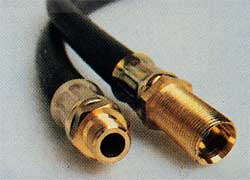Copper Use in Autos Up 40 Percent
 Copper usage in U.S.-built automotive vehicles has risen sharply during the past decade, going from about 36 pounds in 1980 to about 51 pounds in 1991, a 40% increase due largely to more copper electrical wiring and connectors in the average vehicle, according to data compiled by the Copper Development Association Inc.
Copper usage in U.S.-built automotive vehicles has risen sharply during the past decade, going from about 36 pounds in 1980 to about 51 pounds in 1991, a 40% increase due largely to more copper electrical wiring and connectors in the average vehicle, according to data compiled by the Copper Development Association Inc.
Copper in electrical and electronic systems has emerged during the past decade as the largest and fastest growing copper application in a typical vehicle.
And "increasingly smart" U.S. automobiles are likely to demand a continued increase in the use of copper wiring. For example, a small, light and economical gyroscope could help pull automobiles out of a skid. Although today's antilock braking systems can detect the turning of individual wheels, they cannot measure the sideways spinning of a car in a skid. A gyroscope device could add this sensing capability. According to a New York Times article, several companies in the U.S. and Japan have prototypes under review.
General Motors Corporation's Delco Chassis Division says it is considering sensor options other than the gyroscope, "but whichever system is chosen, it will be copper-wired," a spokesman says.
Non-electrical uses for copper in the average vehicle include the radiator and heater, oil coolers and other heat transfer components, clutch and brake linings, aluminum alloying additions, plating, and a variety of small brass parts and fittings.
Also in this Issue:
- NASA Relies on Copper for Shuttle Engine
- Copper Buffalo to Roam Wyoming
- Demand Increases for Copper Busbars
- Solid Brass Padlocks Now Available to Consumers
- Special Coatings, Packaging Products Keep the Shine on Copper and Brass
- Copper Use in Autos Up 40 Percent
- Copper Wire Ensures Performance of New Antilock Brake System
- Copper to Replace Aluminum in New Chip Technology
